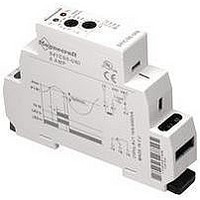841CS5-UNI Magnecraft / Schneider Electric, 841CS5-UNI Datasheet

841CS5-UNI
Specifications of 841CS5-UNI
Related parts for 841CS5-UNI
841CS5-UNI Summary of contents
Page 1
... Time delay relays are simply control relays with a time delay built in. Their purpose is to control an event based on time. The difference between relays and time delay relays is when the output contacts open & close control relay, it happens when voltage is applied and removed from the coil ...
Page 2
FUNCTION DEFINITION TABLES Function Operation A. When the input voltage U is applied, timing delay t begins. Relay contacts R change state after time delay is complete. Contacts return to their shelf state ON DELAY Power On when power U ...
Page 3
Advantages of the 841 Current Sensing Relay Input Indication Green LED Light. Input Terminals Accepts AWG Wire. 5/10 Output Indication Red LED Light. Current Sensing Adjustment Knob Sense Anywhere from 10% to 100% of the Rated ...
Page 4
The 841 Current Sensor Series is a complete current sensing solution in one modular package which mounts directly to a DIN rail. This product allows the user to monitor the current of one circuit ( amps) and switch ...
Page 5
... UL, CE °C -30…+70 °C -20…+ grams 60 Current Sensing Adjustment Knob Time Delay Output Terminals DIN Rail Mounting 841CS2-UNI 841CS5-UNI 841CS8-UNI SPDT SPDT SPDT Silver Alloy Silver Alloy Silver Alloy 15 15 240 AC, 50/60 Hz 240 AC, 50/60 Hz 240 AC, 50/ 1/2 @ 120VAC ...
Page 6
... Standard Part Numbers Part Number Input Voltage 841CS1-UNI 24...240 VAC 841CS2-UNI 24...240 VAC 841CS5-UNI 24...240 VAC 841CS8-UNI 24...240 VAC Part Number Builder Series Relay Style 841 = SPDT CS = Current Sensor 2.6 MAX 1.35 (34.2) 0.63 (16) 3.5 (90) 1.8 (45.3) 2.7 (67.5) 0.236 ( Sol 105 A www ...











